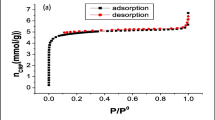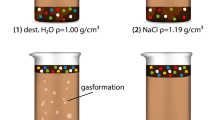Abstract
In the present study, dispersive solid-phase extraction (DSPE) with a sorbent of metal–organic framework/ polypyrrole (MOF/PPy) composite was performed to measure the pesticides residual by gas chromatography (GC). For this purpose, MOF/PPy as sorbent was first synthesized and characterized. The results showed that the synthesis was successful. The present sorbent was used to extract organophosphate and triazole pesticides from an aqueous medium. DSPE was followed by a dispersive liquid-liquid microextraction (DLLME) method for further pre-concentration. Then, the extraction conditions were optimized to obtain precision, accurate and sensitive analytical signals. In the developed method, a wide linear range in the range of 0.5–5000 μg/L (R2 > 0.99) was obtained for most analytes. The developed method was also successfully used to measure pesticides in real samples of tap water, apple juice, grape juice and carrot juice. The benefits of this method can be appropriate inter and intra-day repeatability and the acceptable limit of detection (LOD) and limit of quantification (LOQ).


















Similar content being viewed by others
References
Abbasalizadeh A et al (2022) Riboflavin as a green sorbent in dispersive micro-solid-phase extraction of several pesticides from fruit juices combined with dispersive liquid–liquid microextraction. J Sep Sci 45(9):1550–1559
Damalas CA, Eleftherohorinos IG (2011) Pesticide exposure, safety issues, and risk assessment indicators. Int J Environ Res Public Health 8(5):1402–1419
Farajzadeh MA, Mohebbi A (2018) Development of magnetic dispersive solid phase extraction using toner powder as an efficient and economic sorbent in combination with dispersive liquid–liquid microextraction for extraction of some widely used pesticides in fruit juices. J Chromatogr A 1532:10–19
Farajzadeh MA, Safi R, Yadeghari A (2019) Combination of QuEChERS extraction with magnetic solid phase extraction followed by dispersive liquid–liquid microextraction as an efficient procedure for the extraction of pesticides from vegetable, fruit, and nectar samples having high content of solids. Microchem J 147:571–581
Farajzadeh MA, Yadeghari A, Khoshmaram L (2017) Combination of dispersive solid phase extraction and dispersive liquid–liquid microextraction for extraction of some aryloxy pesticides prior to their determination by gas chromatography. Microchem J 131:182–191
Fattahi N et al (2007) Solid-phase extraction combined with dispersive liquid–liquid microextraction-ultra preconcentration of chlorophenols in aqueous samples. J Chromatogr A 1169(1–2):63–69
Hemmati M, Rajabi M, Asghari A (2017) Ultrasound-promoted dispersive micro solid-phase extraction of trace anti-hypertensive drugs from biological matrices using a sonochemically synthesized conductive polymer nanocomposite. Ultrason Sonochem 39:12–24
Jiang H-L et al (2021) Determination of trace bisphenols in functional beverages through the magnetic solid-phase extraction with MOF-COF composite. Food Chem 345:128841
Juhascik MP, Jenkins AJ (2009) Comparison of liquid/liquid and solid-phase extraction for alkaline drugs. J Chromatogr Sci 47(7):553–557
MA C, et al.(2011) Synthesis and characterization of polypyrrole (PPy) thin films. Soft Nanosci Lett, 2011.
Maya F et al (2019) Immobilization of metal–organic frameworks on supports for sample preparation and chromatographic separation. Chromatographia 82(1):361–375
Mogaddam MRA et al (2020) Dispersive solid phase extraction combined with solidification of floating organic drop–liquid–liquid microextraction using in situ formation of deep eutectic solvent for extraction of phytosterols from edible oil samples. J Chromatogr A 1630:461523
Montes R et al (2009) Solid-phase extraction followed by dispersive liquid–liquid microextraction for the sensitive determination of selected fungicides in wine. J Chromatogr A 1216(29):5459–5466
Płotka-Wasylka J et al (2016) Modern trends in solid phase extraction: new sorbent media. TrAC, Trends Anal Chem 77:23–43
Röhr A et al (2005) Food quality and safety––consumer perception and public health concern. Food Control 16(8):649–655
Safarifard V et al (2016) Influence of the amide groups in the CO2/N2 selectivity of a series of isoreticular, interpenetrated metal–organic frameworks. Cryst Growth Des 16(10):6016–6023
Samadi S, Sereshti H, Assadi Y (2012) Ultra-preconcentration and determination of thirteen organophosphorus pesticides in water samples using solid-phase extraction followed by dispersive liquid–liquid microextraction and gas chromatography with flame photometric detection. J Chromatogr A 1219:61–65
Shahid M, Mohammad F (2013) Green Chemistry approaches to develop antimicrobial textiles based on sustainable biopolymers: a review. Ind Eng Chem Res 52(15):5245–5260
Shayegan H et al (2020) Efficient removal of cobalt (II) ion from aqueous solution using amide-functionalized metal-organic framework. Q J Iran Chem Commun 8(3):190–200
Wang Q et al (2014) A novel method based on combining ultrasonic-assisted dispersive solid-phase extraction and low-density solvent dispersive liquid–liquid microextraction (UA-DSPE-LDS-DLLME) for the determination of organophosphorus pesticides in soil. Anal Methods 6(18):7335–7342
Zeiadi S, et al. (2020) Combination of dispersive solid phase extraction with lighter than water dispersive liquid–liquid microextraction for the extraction of organophosphorous pesticides from milk. Int J Environ Anal Chem,: p. 1–14.
Zhao RS et al (2009) Sensitive determination of amide herbicides in environmental water samples by a combination of solid-phase extraction and dispersive liquid–liquid microextraction prior to GC–MS. J Sep Sci 32(7):1069–1074
Żwir-Ferenc A, Biziuk, M. (2006) Solid Phase Extraction Technique--Trends, Opportunities and Applications. Polish J Environ Stud, 15(5).
Acknowledgements
The authors are thankful for the provided financial support by Yasouj University for the current research.
Author information
Authors and Affiliations
Corresponding author
Additional information
Publisher's Note
Springer Nature remains neutral with regard to jurisdictional claims in published maps and institutional affiliations.
Rights and permissions
Springer Nature or its licensor holds exclusive rights to this article under a publishing agreement with the author(s) or other rightsholder(s); author self-archiving of the accepted manuscript version of this article is solely governed by the terms of such publishing agreement and applicable law.
About this article
Cite this article
Shokouhmandi, Z., Shokrollahi, A. Polymer-coated MOF for effective pesticides’ sorbent in combined DSPE-DLLME method. Chem. Pap. 77, 321–334 (2023). https://doi.org/10.1007/s11696-022-02432-5
Received:
Accepted:
Published:
Issue Date:
DOI: https://doi.org/10.1007/s11696-022-02432-5




